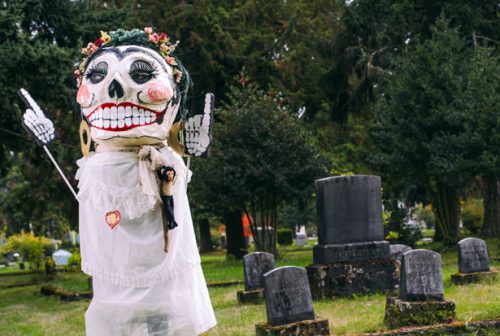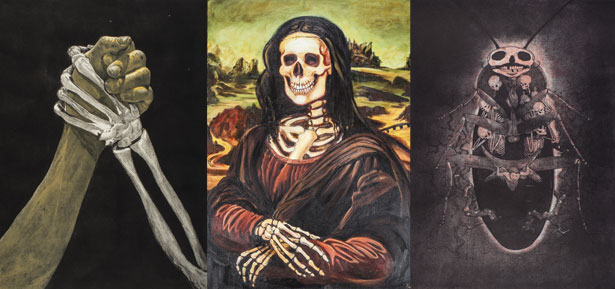
Día de los Muertos is not “Mexican Halloween.” No matter how many times Latino and Chicano communities explain why co-opting the holiday’s religious-based imagery is offensive, the commercialization and uninformed appropriation of the holiday proliferates, from plastic masks at the mall to Disney’s attempt to trademark the holiday last May.
In defense of the uninformed and uninitiated, Día de los Muertos (Day of the Dead), on its surface, is an incredibly attractive celebration that appears to easily fit within the U.S. celebration of Halloween. There’s the playful calacas (skeletons) imagery, the intoxicating smells of burning copal (a tree resin incense) and pan de muerto (bread molded into skulls and crossbones), and the explosion of color from the ofrenda (a sort of shrine), adorned with cempasúchils (orange marigolds), brightly decorated calaveras de azúcar (sugar skulls), and papel picado (cut paper banners and flags). There’s also the proximity to Halloween (DDLM falls on Nov. 1 and 2) that makes it all the more tempting to smash the two holidays into one colorful, candy skeleton blob.
But in doing so, thousands of years of Mesoamerican identity — cultural and religious traditions — are obscured. Where Halloween has mostly forgotten its historical roots, which, depending on who you ask, may be found in Celtic Christianity or paganism, Día de los Muertos is a living, breathing holiday. Mexico and much of Latin America, and more recently communities in the U.S., have not strayed far from traditions of celebrating lost souls and the cycle of life and death. Whereas Halloween dallies in ghosts and goblins, evil spirits and creatures from hell, DDLM is born of cultures where the concepts of “hell” and “evil” did not exist (that is, they didn’t exist before the Spanish-Catholic conquest and colonization of Mexico in the 16th century). In fact, DDLM was not celebrated on Nov. 1 and 2 until after the conquest.
Luckily, here in Eugene, we have a community trying to educate the uninformed so that a holiday like DDLM will become richer for everyone and not go the way of foam sombreros and fake mustaches like Cinco de Mayo. Maude Kerns Art Center is hosting its 20th Annual Día de los Muertos exhibit featuring the work of 25 artists and eight altars or ofrendas Oct. 18 through Nov. 8.
The opening reception Oct. 18 will feature music by Springfield High School’s Mariachi del Sol and dance by Ballet Folklórico Alma de México. UO MEChA, Oak Hill School and the Jordan Schnitzer Museum of Art will continue the DDLM celebrations, Oct. 29-30 and Nov. 1-2, which have been happening on campus for more than 30 years, complete with art studios led by renowned Mexican ceramic artist Martin Guevara Luna, educational presentations and two art exhibits at the JSMA. The exhibits, Posada: 100 Años and Homenaje a Posada, run Oct. 29 through Dec. 15, and will commemorate the famed artist and political cartoonist José Guadalupe Posada, who created the imagery around DDLM that is so popular today. The museum ofrenda will be dedicated to Posada (2013 is the 100th anniversary of his death), Chilean poet Pablo Neruda and members of the community who have passed away.
But, before we can celebrate, let’s educate. Here’s a (highly abridged) look at the history and art surrounding Día de los Muertos, and perhaps why you should think twice before painting a DDLM skull on your face come Halloween.
RELIGIOUS ROOTS
“First, people need to understand what is the meaning of the celebration,” Armando Morales tells me over a cup of coffee. “Death in Mexico is very important.” Morales has been a cultural icon in Eugene for more than 30 years, after moving from Guanajuato, Mexico, in 1978. Morales, a Spanish teacher at Oak Hill School for two decades and a community advisor for UO MEChA, kicked off the first Eugene DDLM celebrations in 1981 and continues to curate the celebrations at the JSMA and Oak Hill School. (MEChA is a nationwide Chicano student organization.)
In Mexican Christianity (a mixture of Mesoamerican beliefs and Catholicism), Morales explains, “It is a challenge to die.” Those who die in battle, giving birth, as infants, from drowning or other water-related deaths go to their respective heavens. But for the rest, Morales says, there are nine steps, or tests, to pass before reaching Mictlan (the Land of Death). These stages include traversing mountains that crash together and crossing underground rivers and vast deserts.
“That is why when you die in Mexico, they bury you with a sack of food, a glass of water, with blankets —because it is going to help you pass these stages,” he says. “This is the philosophy that we have in this celebration,” adding that “We believe that our dead people come to the earth and visit us and we receive them with welcome, with food, with drinks, with everything. That is why we have ofrendas.” (Morales is adamant the proper term is ofrenda: “It is not altar; it is ofrenda because you offer.”)
These ofrendas can be considered the beating heart of DDLM. The bright colors and scents — of marigolds, copal, sugar skulls, colorful banners — are there to help guide spirits to and from the ofrenda. In some places, family members will lay down paths of marigold petals from a grave to an ofrenda so the returning spirits don’t get lost. Their portraits at the ofrenda, along with their favorite things (food, books, cigarettes) welcome these spirits — usually deceased family members and friends. These memorials span two days, Nov. 1 for Día de los Inocentes (for children’s spirits) and Nov. 2 for Día de los Muertos (for adult spirits).
Local artist Analee Fuentes, who created a painting specifically for Maude Kerns’ DDLM celebration, makes a home ofrenda on her dresser for her grandmother every year. “They’re not really dead until we no longer speak their name,” she says.
 |
| Oak Hill teacher Armando Morales has been a local musician and host of KLCC’s ¡ahora si! for more than 30 years |
 |
|
From left to right: Calavereando Conmigo (Living Recklessly With Me) by Roberto Acosta Yanes shows at JSMA, Bona Lisa by Analee Fuentes, La Cucaracha (The Cockroach) by Francisco Palacios Olmos shows at JSMA
|
DEATH WELCOMES ART
These religious and cultural beliefs inform the concept of and attitude toward death in Mexico, which shine through in the art of Día de los Muertos, and vary wildly from beliefs held in the U.S.
“It’s part of your daily life. People die and you’re going to die too,” says Jill Torres, a teacher at Eugene’s Buena Vista Spanish Immersion School and a community adviser for UO MEChA, who will be giving educational DDLM presentations at the JSMA. “Here, it’s like this whole taboo. You say people ‘passed away.’ You can’t even say ‘they died’ because it’s considered insensitive.”
Fuentes, who paints her own collection of DDLM-inspired work like skeleton mermaids and a skeleton Frida Kahlo, points out there is a “strong element of humor” in the art — because for Latino cultures, death is not morbid, it’s part of the cyclical nature of life. She uses Posada’s famous “La Catrina” etching from 1910, depicting a lady skeleton wearing a fancy hat bursting with plumes and flowers, as an example. The image, she explains, illustrates that regardless of wealth and class, we all die. This good humor can be seen in the holiday’s other art forms, such as elaborately painted ceramics and expressive papier mâché and wooden sculpture.
“La Catrina” and many other reproductions of Posada, as well as original works inspired by Posada, have been shipped from Mexico to the Jordan Schnitzer for the exhibits, thanks in part to Morales. Morales worked with the Mexican government — Instituto Estatal de Cultura de Guanajuato, Instituto Nacional de Bellas Artes — to bring Mexican artists and art to Eugene.
“They are concerned about the situation of migrants here in the United States,” Morales says of the cultural wing of the Mexican government. “One of the problems is the loss of identity. By supporting cultural values, then they can have esteem.” For Latino immigrants and the Chicano population in the U.S., Morales says, “lack of esteem is a problem.”
That was a major impetus for Morales: By bringing renowned Mexican art to Eugene, he could help build esteem for and of Mexicans and Mexican-Americans living here.
“When you are proud of who you are, nobody can smash it,” Morales says.
SAVING THE DíA
Perhaps pride can’t be smashed, but there are certainly those who — both intentionally and unintentionally — are destructive to other cultures, especially if those cultures are not predominant. One example is Cinco de Mayo. Both Morales and Torres tell me they have stopped celebrating the holiday.
“I don’t even want to go out sometimes on Cinco de Mayo because I just feel so angry,” Torres says. “It’s always essentialized to the poncho, the sombrero and the giant mustache.”
Morales says the holiday, mostly celebrated in the U.S., started to shift in the ’80s from a Chicano cultural celebration to an excuse to get drunk. “Mexican restaurants and the beer companies,” he says, were at fault. “Then later, in the 1990s, it became worse — worse with the students of the UO. Now they put mustaches and hats on for fraternities and sororities and they walk the streets to find a place to drink,” he says, adding with a wince, “Cinco de Drinko.”
Morales, Torres and Fuentes all agree that beyond drunk college kids perpetuating racist stereotypes, the most real threat to a cultural heritage is commercialization.
“It could start to happen with Día de los Muertos,” Morales says. “Some places think it’s Halloween, Mexican Halloween … It has nothing to do with Halloween.” (In fact, it has started. Flip through newspapers in town, including this one, and find DDLM imagery used to sell Halloween goods and beer.)
“Once you commercialize it, it loses its meaning,” Torres says. “For those of us who hang onto it for that cultural meaning, to have somebody else completely using it to their benefit that’s erasing that meaning is really difficult to deal with.”
But, that doesn’t mean the opposite is true, that no one can celebrate DDLM unless they are Latino or Chicano.
“I don’t own Day of the Dead. Hispanics don’t,” Fuentes says. But she adds for those wanting to celebrate other cultures, “Be aware of what you’re doing. Put things within the context.”
Torres also notes the internal battles she has over this kind of cultural appropriation. “As a younger Latino, it’s hard because it’s like, what parts of the culture can we change and what parts do we need to maintain?” she says. “It’s culture, you can’t limit it. But at the same time, it just feels wrong sometimes.”
At the end of our chat, I ask Morales how he feels about the late Susan Dearborn Jackson — a white American woman, who wrote her UO folklore thesis, “Death and Fiesta,” about DDLM in 1992 — starting the Día de los Muertos celebrations at Maude Kerns 20 years ago.
“Without being Mexican, she promoted Mexican culture. The issue is not white or black or brown or pink,” he says. “The issue is present the real thing. Susan did that. She investigated it. She studied it.”
For more information about the art and events of Día de los Muertos, visit mkartcenter.org, jsma.uoregon.edu, analeefuentes.com and eugeneartelatino.wordpress.com